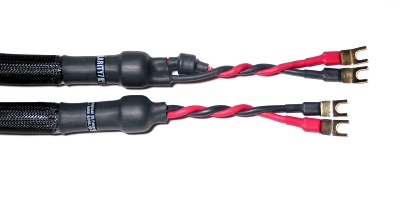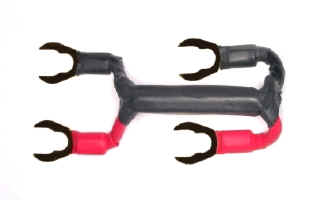You are reading the older HTML site
Positive Feedback ISSUE 5
february/march 2003
empirical audio
Clarity 7 speaker cables
Transparency vs. Opacity in speaker cables, Part Five
as reviewed by Bob Neill

BOB NEILL'S SYSTEM: LOUDSPEAKERS ELECTRONICS SOURCE CABLES ACCESSORIES
|
I'd like to welcome another utterly natural sounding speaker cable up onto the dais, alongside Audience Au24. There are some differences, and I'll get to the comparison in a minute, but first to my impressions of Clarity 7. Every star deserves its own moment in the spotlight.
Clarity 7 in my system sounds just slightly and naturally warm, clear, with a wonderful sense of ease. No ultra vivid scene, no excess dramatics, no amber hue, neither hyped nor softened transients. Presence rather than transparency is the word that comes to mind, but there is certainly no hint of opacity. There is just no insistence, urgency, or overlit quality that says "Transparency!"
Stephon Harris's philosophically overblown but musically compelling The Grand Unification Theory (Blue Note)—once I got the phase right—was both impactful and smooth on Clarity 7. Brass, reeds, and percussion—including Harris's inimitable vibes—were all dramatically present, but there was also an intoxicating ease to the proceedings. No absence of authority but no insistence on it either. I switched to my current reference, Audience Au24, and found everything slightly warmer, slightly softer, and, interestingly, more coherent sounding. Coming to Au24 directly from Clarity 7, you can get the impression the Audience cord is bringing a simplifying and selective clarity to its presentation. On the Harris CD, I was somewhat less aware of detail, less aware of hearing the distinctness of each sound than I was with the Empirical cord. But I rather liked the net result and realized that what was appealing to me was an overall sense of togetherness, integrity—coherence. This is a very difficult quality to talk about without sounding a little ‘Eastern.' In contrast, the Clarity 7 was a little more objective sounding, the contrast among instruments was more striking—and I liked that. Once I replaced the Au24 jumpers with Empirical's jumpers, called Geckos, this ability to discriminate among instruments increased a bit as the whole presentation became still clearer. On some recordings, as I proceeded through the rest of the audition, I found I preferred Clarity 7's un-insistent but exciting resolution to the Au24's coherence.
I need to say, and repeat from time to time for emphasis, that the difference
between the Au24 and Clarity 7 is not striking and not really even much of an issue until
you focus on it, which is a reviewer's task. These cords are much more like each other in
their natural warmth and ease than like anything else I've heard lately. Both are clearly
siblings and it is entirely possible I could not distinguish between them consistently in
a blind comparison. But doing the back and forth with the Harris CD, their difference did
come out: Au24 puts all it marbles on coherence, Empirical, with a wink toward
On a CD of Vivaldi Chamber Concertos played by the virtuoso Italian group, Il Guardino Armonico (Teldec), the strings are a bit more reckless and full-bodied on Clarity 7. The presentation seems a little airier but also more lively and more compelling to listen to. The Empirical cord digs into the instruments a bit more than does Au 24 and seems to give a fuller account of them. This is a recording where Clarity 7 will be the slight favorite for some listeners. Au24 gives a little more controlled and tamed version of the music, which is nevertheless very appealing in its way. It would be easy to adjust to either presentation and not think of the other.
The Mosaiques Quartet playing Mozart's Prussian Quartets (Astree). On this recording, Clarity 7 is a bit more ‘objective' and cool sounding than Au24. The Empirical cord is not an analytic cord, don't get me wrong, but it also does not indulge these early strings as Au 24 does. On the Audience cord, the strings are a bit gentler, lighter, a little more elegant. In contrast to Clarity 7, again, the presentation doesn't dig into the music as physically. But it also ends up a little more appealing, a little less analytic. Both presentations are more civilized and appropriate for the music than any of the other cords I've heard: neither is overly romantic or overly strict.
Time Out
Time to step back a bit. I find myself in the right architectural period but between styles! If you like the ‘natural' sound as I have been describing it in this series of reviews, you can't go wrong with either of these cords. Both grow out of a respect for how music actually sounds in a live venue and are not out to sell you something else—something more dramatic or vivid or exciting. If you like your reproduced music un-aggressive but naturally warm and present, listening to these two cords will help you fine tune your preferences. Do you prefer fulsome Georgian or subtler Federal?
Here is another take on the difference between these cords. A year ago, in trying to characterize Spendor SP1/2's, I defamed a word. I called them "charming" with a bit of a condescending smile in my voice. The truth is, the Spendors are charming, but so is a lot of music, which is why Spendors survive this kind criticism. They have real charm. Au24 is also genuinely charming, with even a little of the spellbinding quality that word connotes. I have come to favor the modest and subtle spell that Au24 weaves, which is like the spell music itself often weaves, so I have come to call this charm "coherence," which is what I think is at the core of its appeal. And "coherent" is a nicer thing to call an audio component than "charming"! Clarity 7, while similar to Au24 in its overall natural presentation, is not charming, nor is it conspicuously coherent. It gives us more sense of music before it has begun to do its number on us, before it all comes together into a point of view. It feels absolutely unprocessed, uncontoured, uninterrupted. It has the sense of freshness I have attributed to the Naim CDS2.
Time in
On Koroliov's Bach,Well-Tempered Clavier II (Tacit), on piano, Clairity 7 seems to go after the whole piano and gives it to us with great éclat. Everything seems a bit more open and expressive than on the Au24, which in turn is more lyric sounding, slightly focused, tamer, special. The piano is less brilliant on the Audience cord. It is eloquent in its way, the kind of eloquence that goes with utter poise, balance—again, coherence. Here, while I liked the Au24 presentation a lot, I found in the end I slightly preferred Clarity 7's view of Koroliov.
On Lennox Berkeley Edition 2, several pieces featuring oboe by composer Berkeley and his son Michael Berkeley, (Chandos), the Empirical cord's view was initially more exciting, though the more I listened and compared, the more I rediscovered that there is also an excitement that comes with great coherence. There is a sense of rightness. Listening to the Berkeleys through Au24 reminded me of my experience years ago with Thiel 2.2's, the only Thiels I could ever bear to listen to. The chief design goal of that speaker was coherence.
Conclusions
A cable (or speaker) with other priorities will sometimes seem to out-perform an extremely coherent one, and that is how the difference will tend to sound: like some thing outperforming another. As I performed the unnatural activity of an A/B comparison of these cords, I got that feeling: Clarity 7 sometimes seemed to outperform Au24. But contrariwise, the component with greater coherence, which sacrifices a bit of contrast and excitement to achieve it, can sneak up on your expectations, which may well be focused on individual aspects of what you're listening to. And steal the day. And I had that experience as well. The Empirical Clarity 7 is superb at getting at specific attributes; Au24 with less flair, is equally good at capturing a sense of the whole. That there is a cost involved in both of these designs is what I'm trying to make clear, and the one you are more willing to incur will likely determine which one you will end up preferring. And, to repeat myself yet again, either way you win.
It would be possible to prefer Au24 or Clarity 7 to each other on principle, to prefer a somewhat clearer presentation to a more coherent one, or vice versa. But I don't recommend it. It is better to hear both in order to see whether in the unnatural practice of discriminating subtle differences between pieces of wire, I have made them greater than they are.
Empirical Clarity 7 is a considerably thicker cable than Audience Au24 but sufficiently flexible to suit any situation I can imagine. It is reasonably priced for its quality, far more reasonable that a great many cords which are its sonic inferiors. I ran it single wired, as I have all of the cords in this survey, using Empirical's own Gecko jumpers.
Clarity 7 speaker cables
Retail:
$679.98, 3 foot pair
$939.98, 6 foot pair
Gecko Jumpers
Retail:
$129.98/pr

Empirical Audio
3240 NW 132 Pl
Portland, OR 97229
TEL: 503. 533. 1772
email address: [email protected]
web address: http://www.empiricalaudio.com
